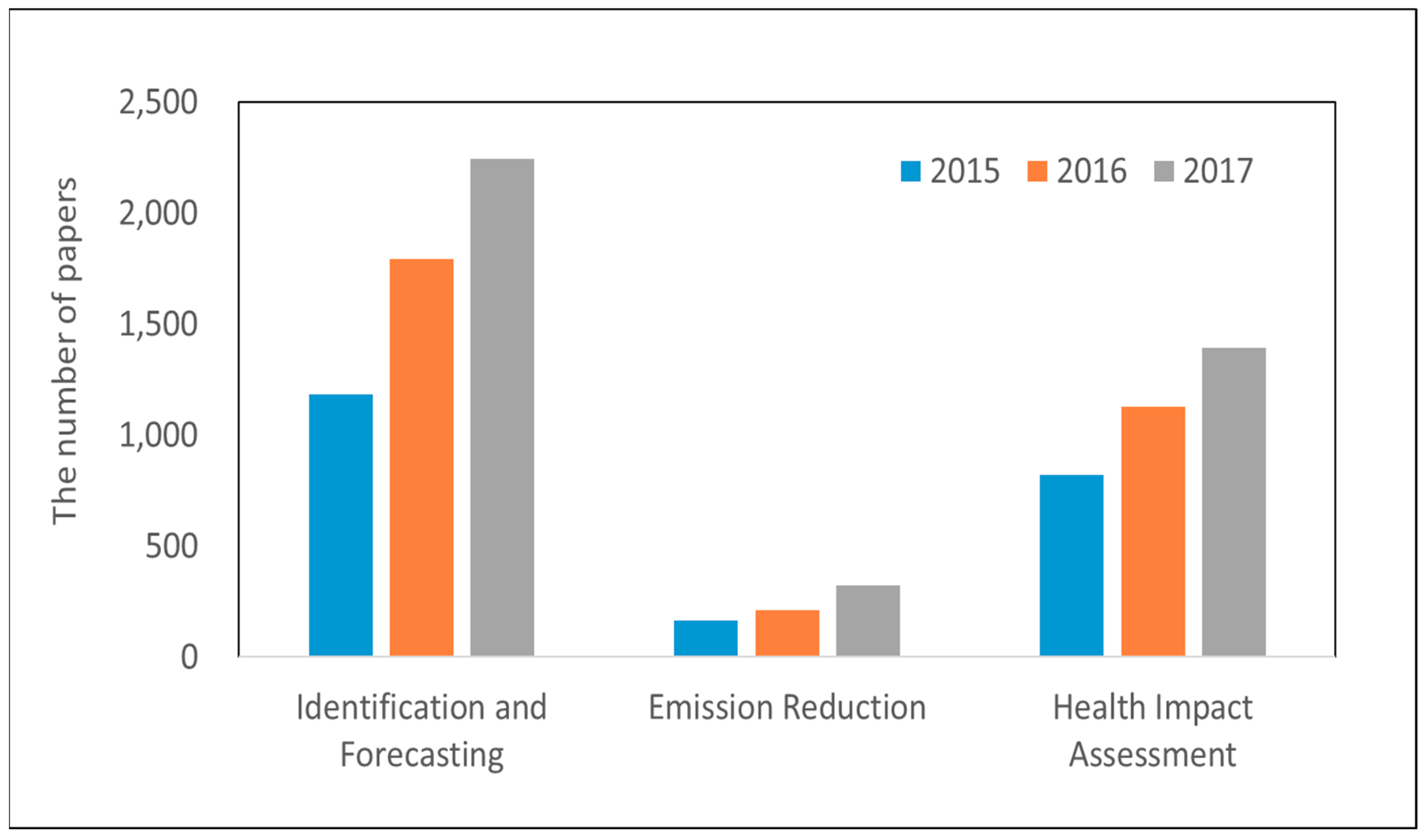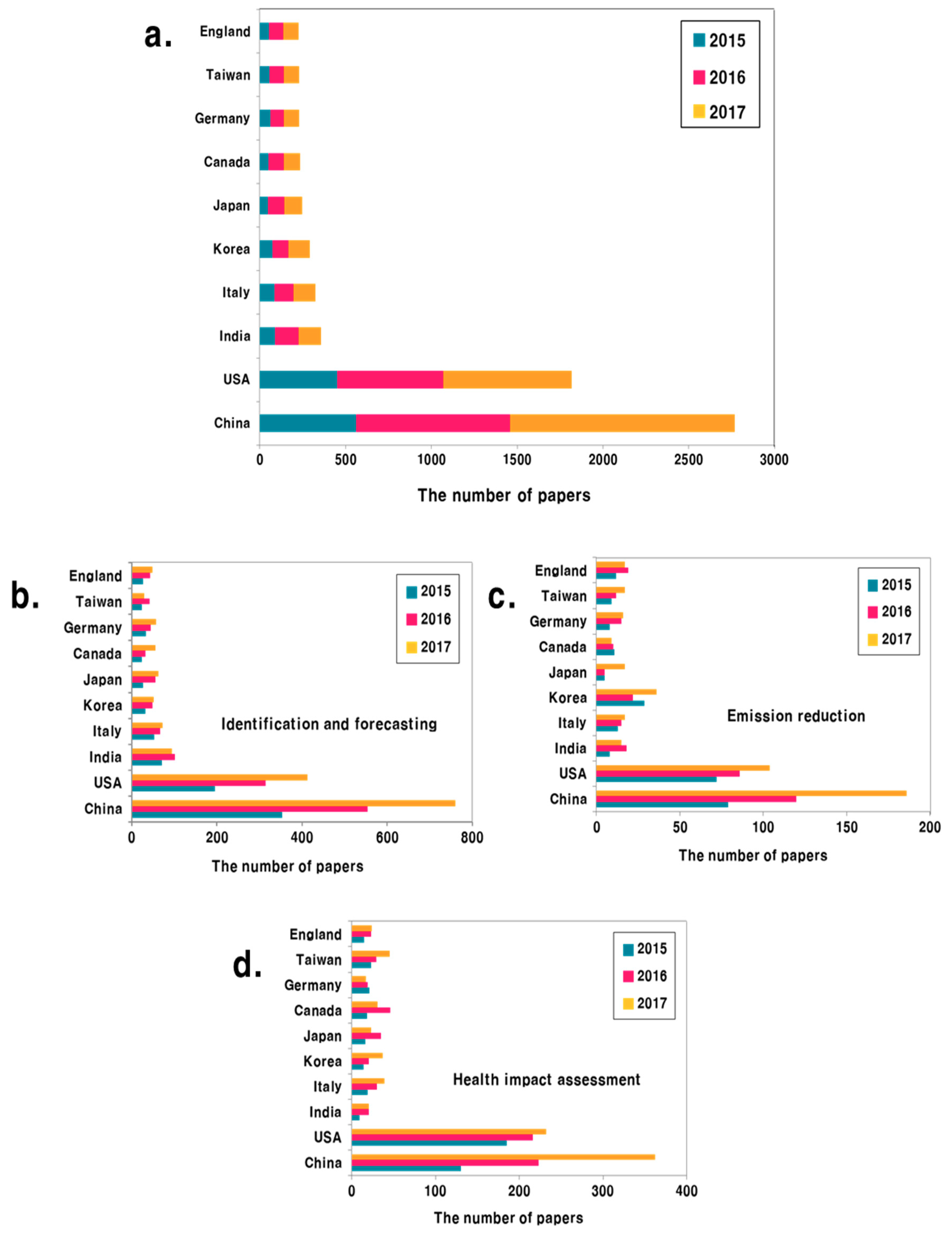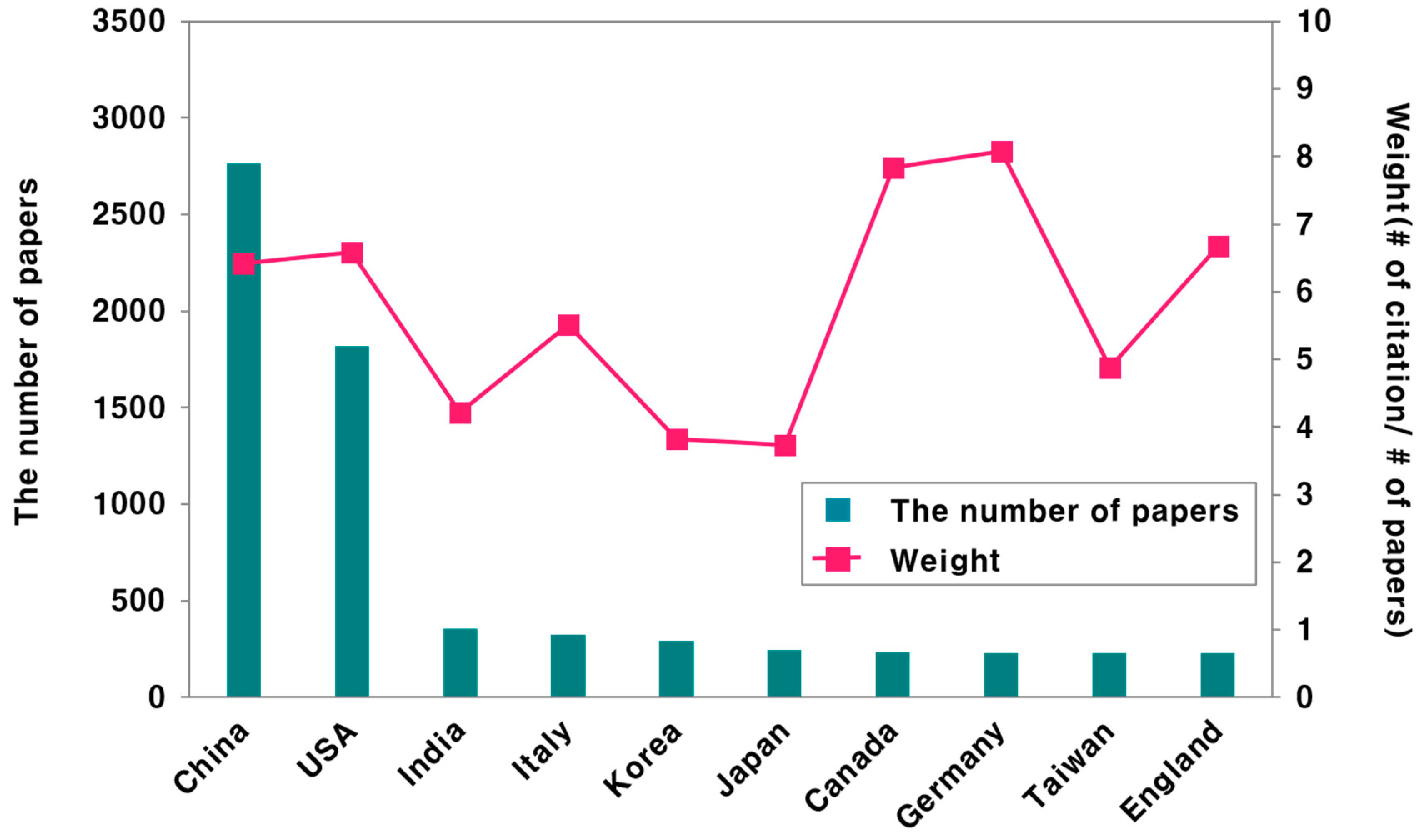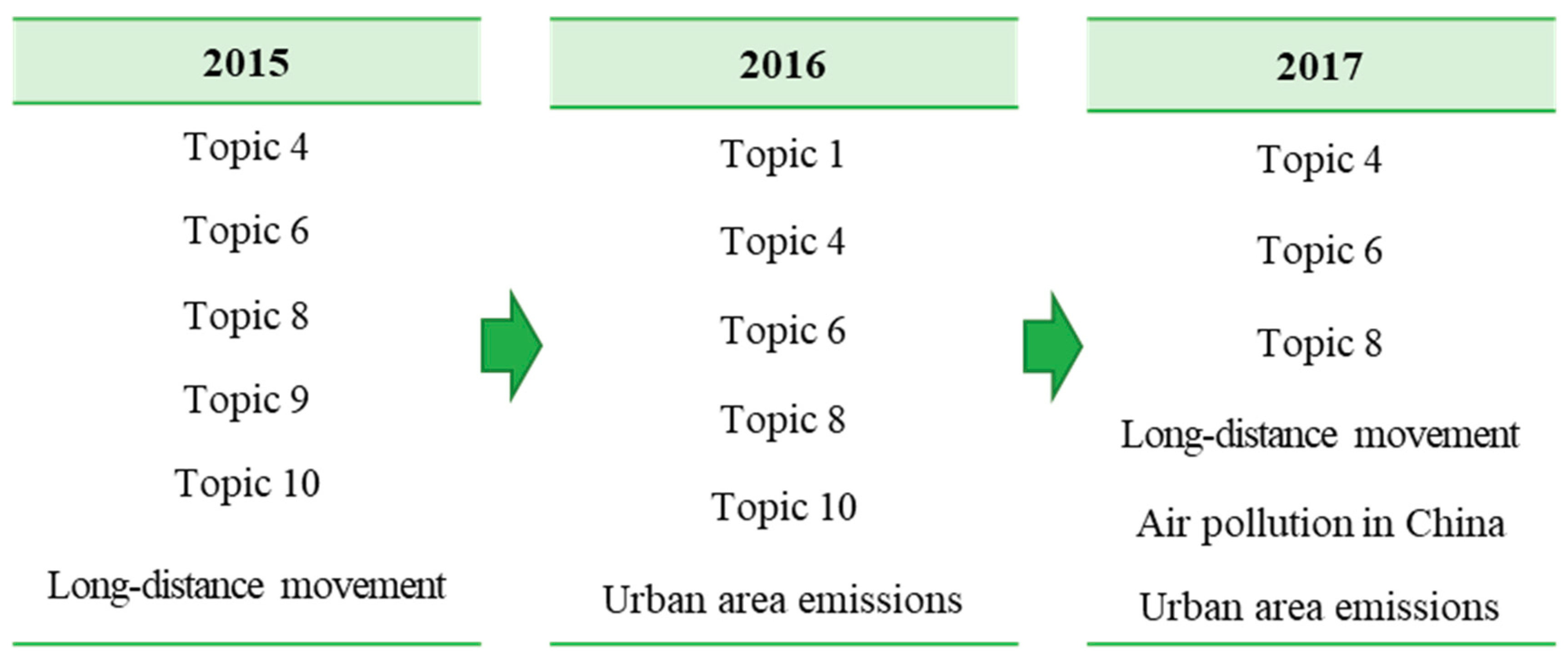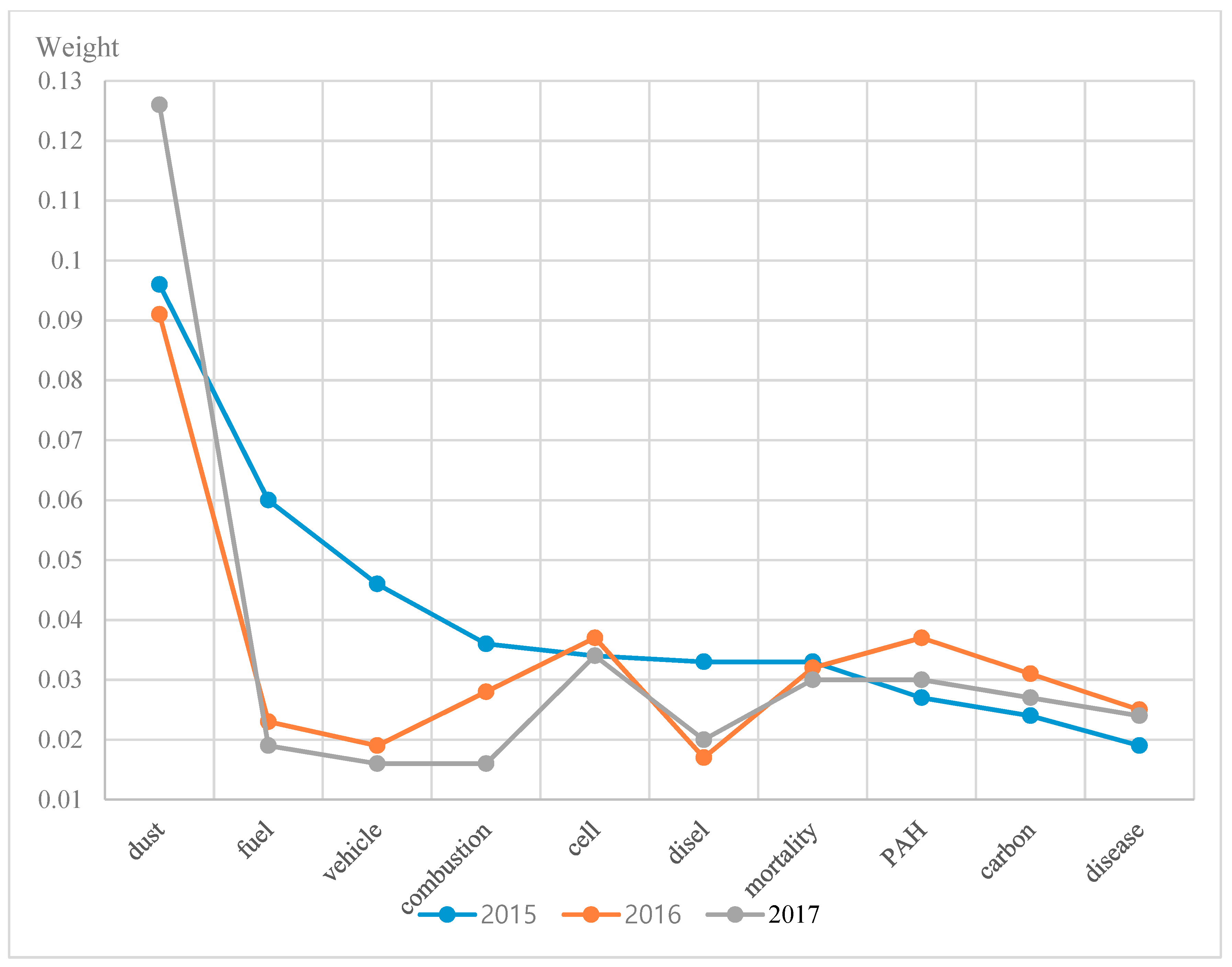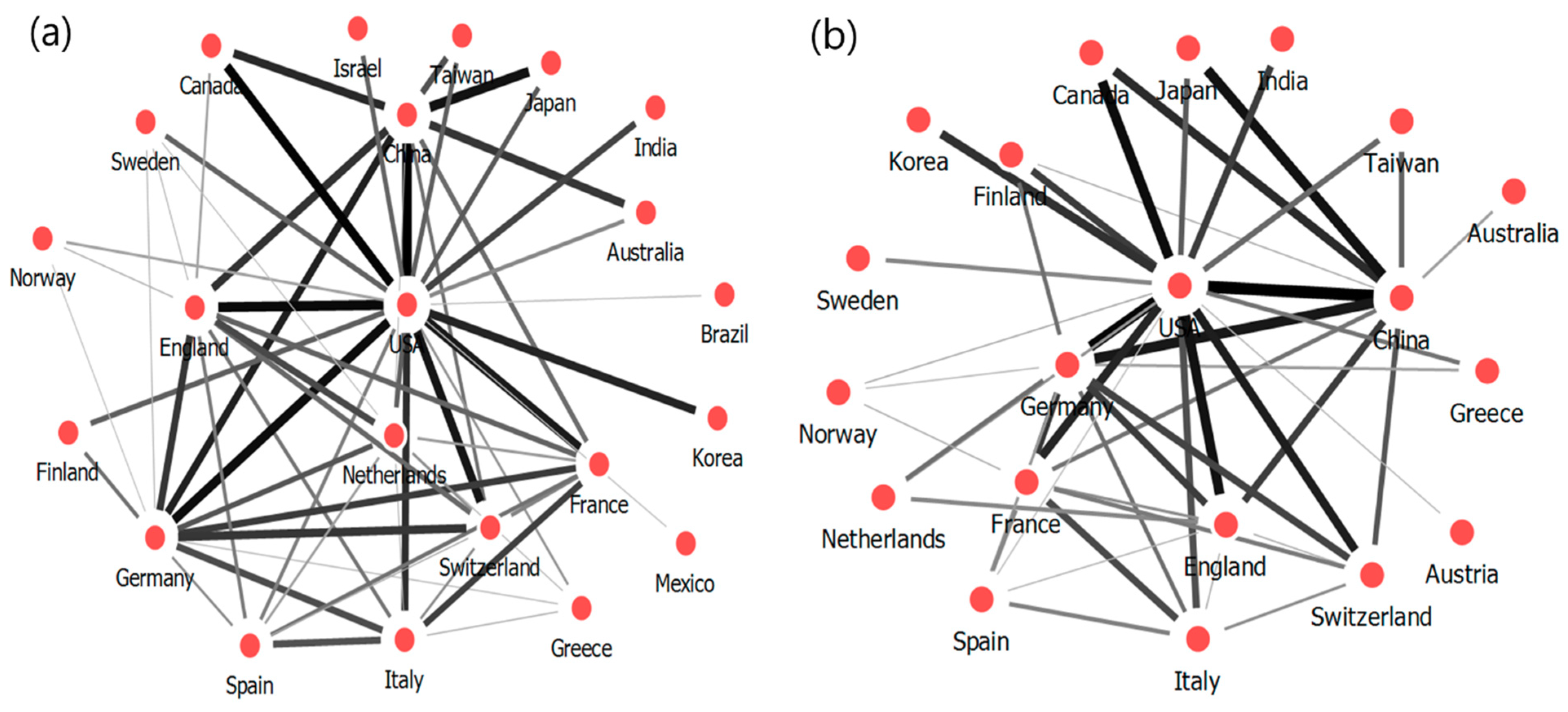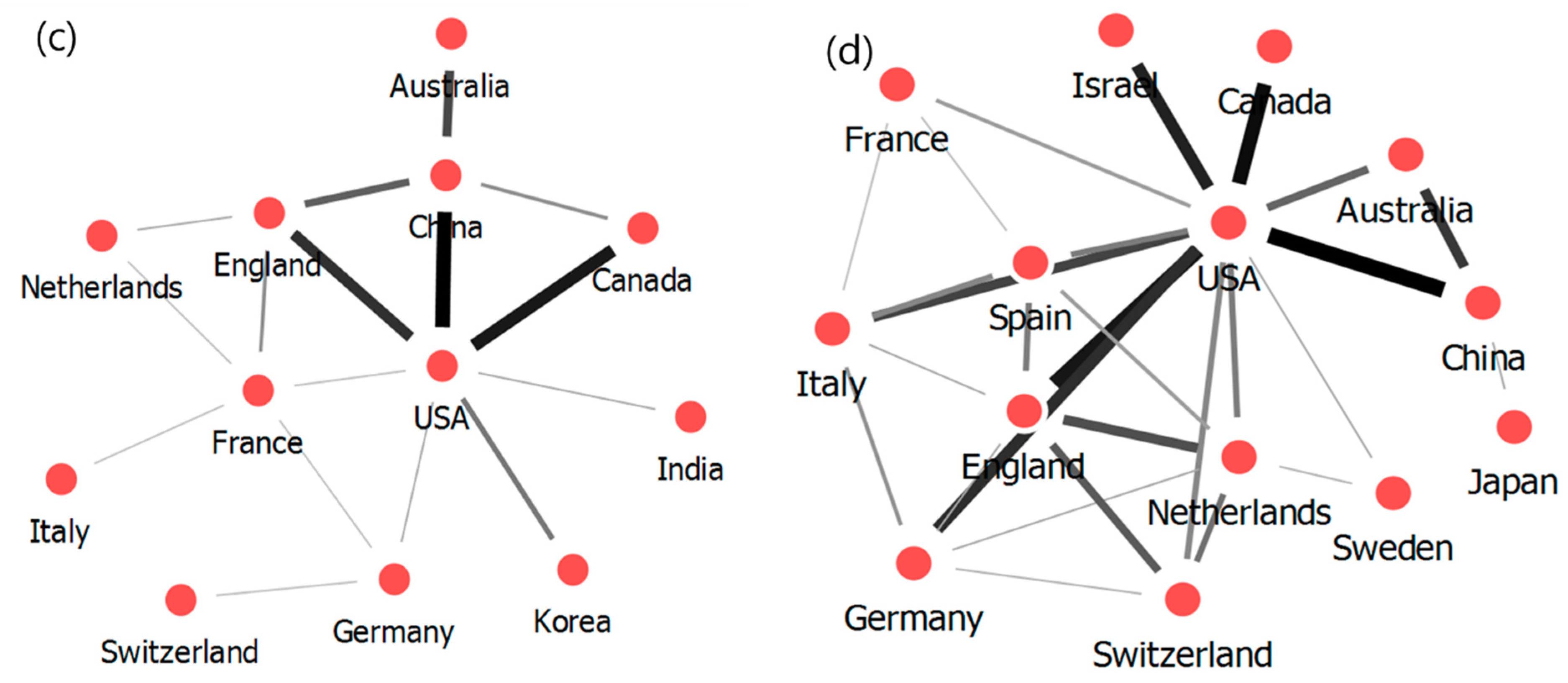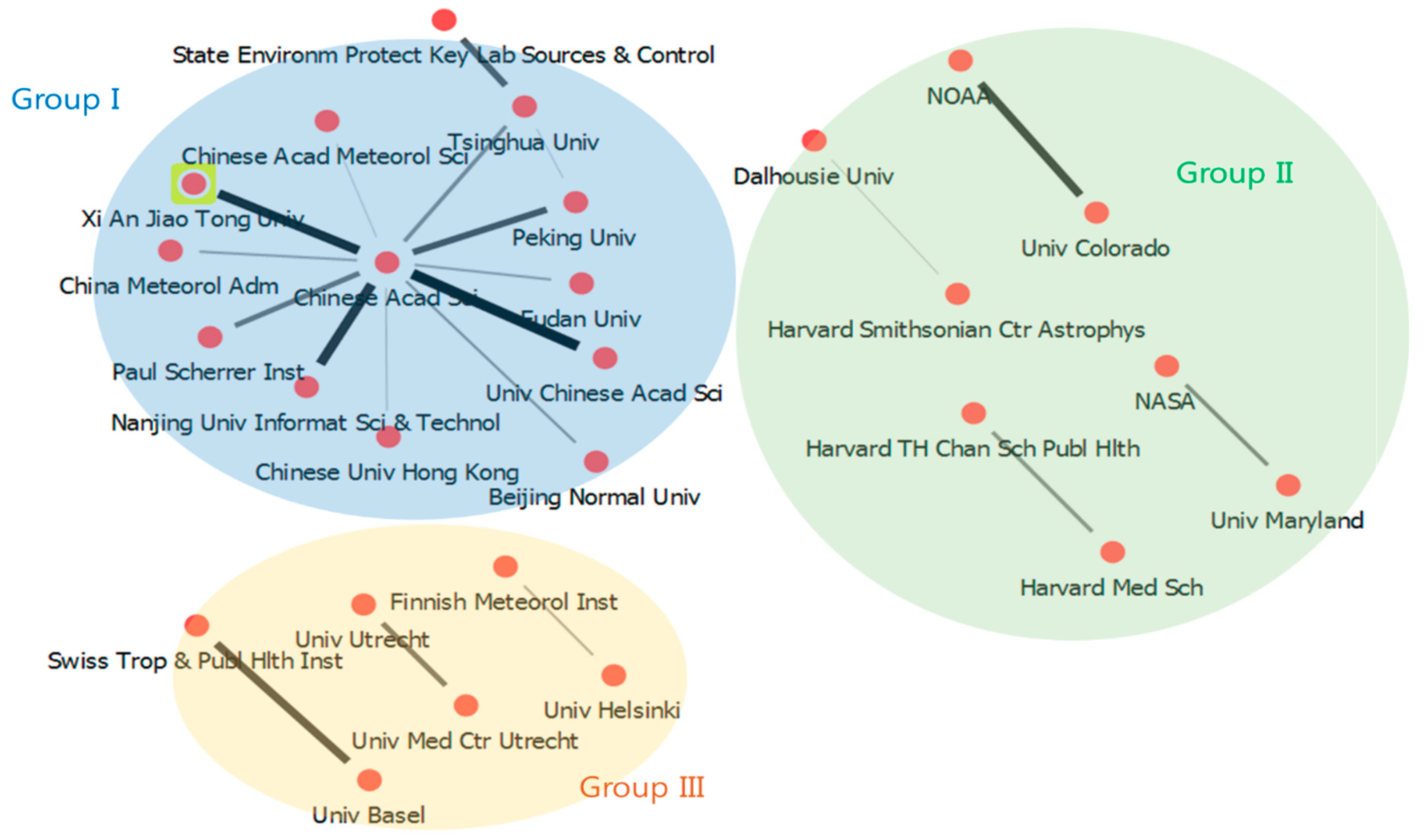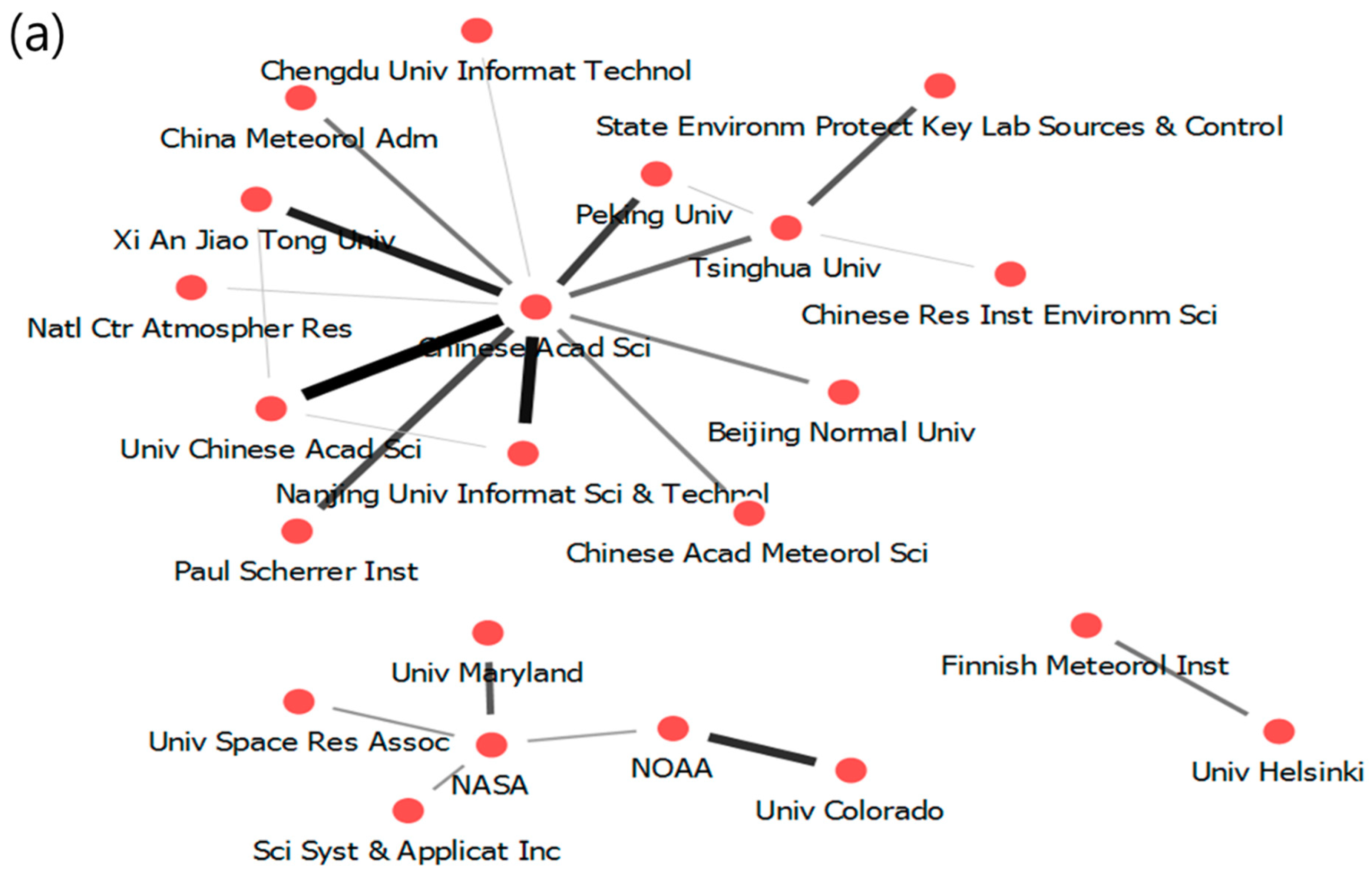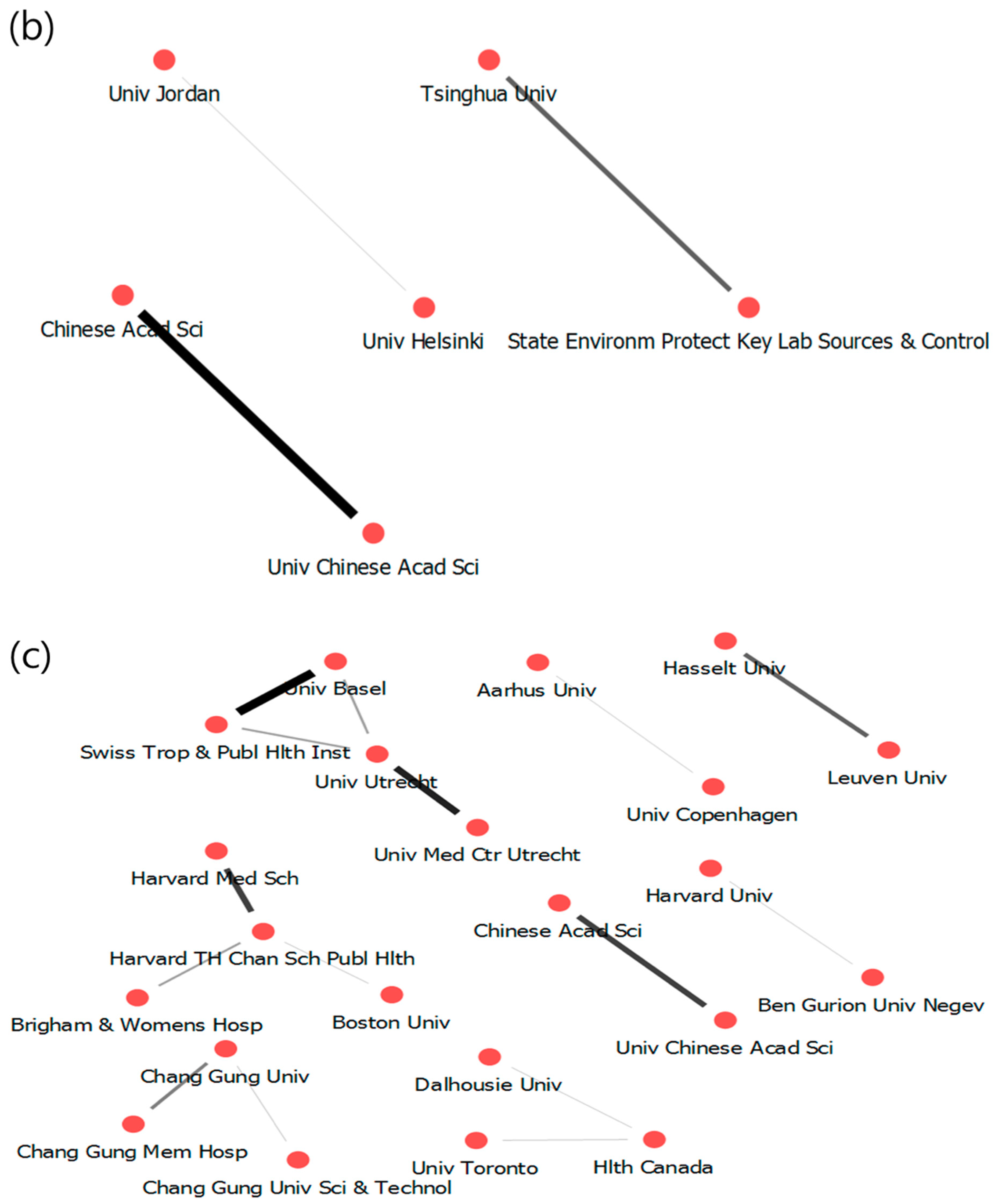1. Introduction
Atmospheric dust can be classified into total suspended particles (TSP) and particulate matter (PM), with the latter characterized by a particle size of 50 μm or less. Both PM
10 and PM
2.5 defined particulate matter as smaller than 10 and 2.5 μm, respectively. PM is primarily generated by the burning of fossil fuels such as coal and oil and in the emissions from factories and vehicles. Exposure to PM varies depending on the characteristics of the local environment such as the weather, seasonal patterns, terrain, and sources, as well as the respiratory characteristics of an individual, but there is direct correlation between PM size and the harm it inflicts on the human body. In general, small particles more readily penetrate the respiratory system and cause serious harm to the human body. Particles smaller than 1 μm have similar behavior to gas molecules, so they can penetrate the lung vacuoles and may enter cellular tissue [
1]. The World Health Organization (WHO) reported that 7 million people die prematurely due to PM, while the International Agency for Research on Cancer (IARC) classified it as a carcinogen in 2013 [
2,
3].
The global population-weighted PM
2.5 concentration increased from 39.7 μg/m
3 in 1990 to 44.2 μg/m
3 in 2015, a rise of about 4.5. Since 2010, the rate of increase has accelerated, with major changes in air pollution levels in more populated countries. This can be attributed to a range of combustion emission sources, including domestic solid fuel use, thermal power plants, agriculture, open burning, and industrial and transportation sectors [
4]. The highest concentrations of PM
2.5 have been found in northern India and Southern Asia, including Bangladesh, followed by Southeast Asia, Eastern China, and Central and Western sub-Saharan Africa. In particular, India and Bangladesh have experienced a sharp increase in exposure since 2010 [
5,
6].
We reviewed research in China, particularly in relation to PM
2.5 concentration and migration problems [
7,
8,
9,
10,
11,
12,
13,
14,
15]. With its rapid economic development and urbanization in recent decades, China has consumed enormous amounts of energy, mainly through coal and fossil fuel. The resulting nitrates and sulfates have led to severe air pollution, particularly the smog associated with PM
2.5, making China one of the most polluted countries in the world in terms of PM
2.5 levels [
16,
17,
18].
In addition, other countries in Asia have experienced the effects of the transport of PM
2.5 from China. For example, the contribution of long-range transport (LRT) and local pollution (LP) to PM
2.5 levels in Taiwan was analyzed [
19]. The 10-year average LRT–PM
2.5 and LP–PM
2.5 contributions were approximately 70% and 30%, respectively, in Northern Taiwan. As with Taiwan, the LRT of PM
2.5 from the Asian continent to downstream areas such as Korea is also possible. Due to this, Korea has exhibited great concern about PM
2.5 pollution, which appears to be worsening. An illustration of this is that the number of public warnings regarding PM
2.5 levels in Korea increased from 1 day in 2013 to 10 days in 2017. In addition, based on online search data over the past decade, interest in PM
2.5 has increased sharply since 2013. The countries within which searches on information regarding PM
2.5 have been most common since 2013 are Taiwan, Japan, China, and Korea, i.e., countries in East Asia. In particular, Korea’s interest in PM began to increase in 2014, with interest at its highest level in 2019.
One of the important features of PM pollution in South Korea is that more than three-quarters of the observed PM is from secondary production. Here, primary PM are originated from human and natural activities. Meanwhile, secondary PM is formed by physical and chemical reactions from precursors including nitrogen oxides, sulfur dioxide, and ammonia. The Korea–United States Air Quality Study (KORUS-AQ) campaign with NASA observed and analyzed the components of PM around the Seoul Metropolitan Area with an aircraft (DC-8) and found that organic matter was the most common source, but sulfates and nitrates accounted for almost half of the total amount of secondary production. PM levels in South Korea are determined by complex processes with a number of variables. Emissions can be controlled for various air pollutants in Korea, but influx is determined by air pollution and weather conditions in countries bordering Korea: China, North Korea, and others [
20]. Therefore, for high concentrations of PM
2.5 that exceed environmental standards, the direct effect of LRT from East Asia, including China, cannot be ignored. This indicates that domestic pollutants and pollutants from upwind sources are responsible for the worst conditions [
21].
Unlike other developed countries, such as Germany and Japan, in which air pollution tends to fall as their economic level increases, South Korea has high PM concentrations and greenhouse gas (GHG) emissions compared to its economic level. This situation is due to its manufacturing-oriented economy and significant coal consumption compared to those of other developed countries. Thus, in order to reduce PM pollution levels, various components of the pollution problem need to be investigated, such as the control of different emission sites, mobile pollutant limits, and climate and weather conditions, to better support government policy in this area. The main objective of the present study was thus to understand the global research trends for PM using text mining and social network analysis. The future direction for R&D investment in order to solve the PM problem in Korea is then discussed.
4. Conclusions
In this study, we utilized topic model and social network analysis to understand the research trends for PM. The main results for the analysis were as follows. First, China and the USA produced the largest number of SCI papers related to PM in 2015–2017. South Korea was ranked in the top five with an average annual increase of 27.7%. Second, the interest in particular research topics changed from 2015 to 2017. New keywords such as PM
10 and NO
2 have newly emerged, and the proportion of research papers on yellow dust and fossil fuel power generation has reduced. In addition, South Korea is pursuing research on various areas of PM, while China is more focused on diagnosis and risk assessment rather than emission reduction. A closer look at the trends of developed countries including the USA, Germany, and France revealed greater interest in smaller dust particles and their sources, the effects of climate change and ozone, and the health effects on vulnerable groups, including pregnant women. Based on these trends, South Korea should emphasize PM
2.5, secondary production, and the health effects on vulnerable groups, while also strengthening the R&D budget for these research fields in the near future. Third, research networks have formed mainly in China and the USA, while South Korea has a weak network structure, with Seoul National University located in the center of the research network in South Korea, and the National Institute of Environmental Science and Korea University also active. South Korea’s technological levels for dealing with PM are only 70% on average compared to those of the USA and Europe, which have the latest technology [
29]. Therefore, in order to enhance the competitiveness of PM technology and to strategically promote it, greater international cooperation with excellent research institutes overseas is required. The limitation for this result is that three years of data can be short to analyze the whole trend and find chronological differences. Thus, future work will include analyzing the research trends by adding the year. PM is emerging as a major issue among neighboring countries because air pollution is a transboundary issue, so joint research is needed to find solutions. It is expected that the results of the present analysis can be used as a foundation for this effort.

